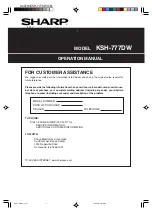
10
End of use
• When the appliance is no longer to be used, make it unusable by removing the mains
power supply wiring.
A.7
Transport, handling and storage
• Due to their size, the machines can be stacked on top of each other during transport,
handling and storage by complying with that specified on the slip placed on the packing.
• Do
not
stand
under
suspended
loads
during
loading/unloading
operations.
Unauthorised personnel must not enter the work area.
• The weight of the appliance alone is not sufficient to keep it steady.
• For machine lifting and anchoring, do not use movable or weak parts such as: casing,
electrical raceways, pneumatic parts, etc.
• Do not push or pull the appliance to move it, as it may tip over.
• Machine transport, handling and storage personnel must be adequately instructed and
trained regarding the use of lifting systems and personal protection equipment suitable
for the type of operation carried out (e.g. overalls, safety shoes, gloves and helmet).
• When removing the anchoring systems, make sure the stability of the machine parts
does not depend on the anchoring and, therefore, that this operation does not cause the
load to fall off the vehicle. Before unloading the machine components, make sure all the
anchoring systems are removed.
• Machine positioning, installation and disassembly must be carried out by specialised
personnel.
A.8
Installation and assembly
• The operations described must be carried out by personnel qualified (refer to E.1
Characteristics of personnel trained for normal machine use
) in compliance with the
current safety regulations, regarding the equipment used and the operating procedures.
• The plug, if present, must be accessible after positioning the appliance in the place of
installation.
• Disconnect the appliance from the power supply before carrying out any installation
procedure.
A.9
Electrical connection
Before connecting, make sure the mains voltage and frequency match those indicated on
the appliance data plate.
• Work on the electrical systems must only be carried out by specialised personnel.
• Connection to the power supply must be carried out in compliance with the regulations
and provisions in force in the country of use; arrange a suitable high-sensitivity manual-
reset differential omnipolar thermal-magnetic switch with contact gap enabling complete
disconnection in category III overvoltage conditions.
• If the power cable is damaged, it must be replaced by the Customer Care Service or in
any case by specialised personnel, in order to prevent any risk.
• Verify that a safety circuit breaker is installed between the power cable of the appliance
and the mains electric line. The contact opening max. distance and leakage current
must comply with the local safety regulations.
• Be sure to power the equipment with systems that are protected against overvoltage;
the manufacturer declines all responsibility for effects due to anomalies induced by the
electrical supply system.
A.10
Machine space limits
• A suitable space must be left around the appliance (for operations, maintenance, etc.).











































